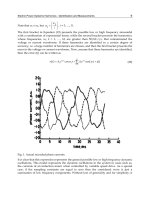Chapter 090. Bladder and Renal Cell Carcinomas (Part 2) docx
Bạn đang xem bản rút gọn của tài liệu. Xem và tải ngay bản đầy đủ của tài liệu tại đây (46.8 KB, 5 trang )
Chapter 090. Bladder and Renal
Cell Carcinomas
(Part 2)
Pathogenesis
The multicentric nature of the disease and high rate of recurrence has led to
the hypothesis of a field defect in the urothelium that results in a predisposition to
cancer. Molecular genetic analyses suggest that the superficial and invasive
lesions develop along distinct molecular pathways in which primary tumorigenic
aberrations precede secondary changes associated with progression to a more
advanced stage. Low-grade papillary tumors that do not tend to invade or
metastasize harbor constitutive activation of the receptor-tyrosine kinase-Ras
signal transduction pathway and a high frequency of fibroblast growth factor
receptor 3 (FGFR3) mutations. In contrast, CIS and invasive tumors have a higher
frequency of TP53 and RB gene alternations. Within all clinical stages, including
Tis, T1, and T2 or greater lesions, tumors with alterations in p53, p21, and/or RB
have a higher probability of recurrence, metastasis, and death from disease.
Clinical Presentation, Diagnosis, and Staging
Hematuria occurs in 80–90% of patients and often reflects exophytic
tumors. The bladder is the most common source of gross hematuria (40%), but
benign cystitis (22%) is a more common cause than bladder cancer (15%) (Chap.
45). Microscopic hematuria is more commonly of prostate origin (25%); only 2%
of bladder cancers produce microscopic hematuria. Once hematuria is
documented, a urinary cytology, visualization of the urothelial tract by CT or
intravenous pyelogram, and cystoscopy are recommended if no other etiology is
found. Screening asymptomatic individuals for hematuria increases the diagnosis
of tumors at an early stage but has not been shown to prolong life. After
hematuria, irritative symptoms are the next most common presentation, which may
reflect in situ disease. Obstruction of the ureters may cause flank pain. Symptoms
of metastatic disease are rarely the first presenting sign.
The endoscopic evaluation includes an examination under anesthesia to
determine whether a palpable mass is present. A flexible endoscope is inserted
into the bladder, and bladder barbotage is performed. The visual inspection
includes mapping the location, size, and number of lesions, as well as a description
of the growth pattern (solid vs. papillary). An intraoperative video is often
recorded. All visible tumors should be resected, and a sample of the muscle
underlying the tumor should be obtained to assess the depth of invasion. Normal-
appearing areas are biopsied at random to ensure no field defect. A notation is
made as to whether a tumor was completely or incompletely resected. Selective
catheterization and visualization of the upper tracts should be performed if the
cytology is positive and no disease is visible in the bladder. Ultrasonography, CT,
and/or MRI may help to determine whether a tumor extends to perivesical fat (T3)
and to document nodal spread. Distant metastases are assessed by CT of the chest
and abdomen, MRI, or radionuclide imaging of the skeleton.
Bladder Cancer: Treatment
Management depends on whether the tumor invades muscle and whether it
has spread to the regional lymph nodes and beyond. The probability of spread
increases with increasing T stage.
Superficial Disease
At a minimum, the management of a superficial tumor is complete
endoscopic resection with or without intravesical therapy. The decision to
recommend intravesical therapy depends on the histologic subtype, number of
lesions, depth of invasion, presence or absence of CIS, and antecedent history.
Recurrences develop in upward of 50% of cases, of which 5–20% progress to a
more advanced stage. In general, solitary papillary lesions are managed by
transurethral surgery alone. CIS and recurrent disease are treated by transurethral
surgery followed by intravesical therapy.
Intravesical therapies are used in two general contexts: as an adjuvant to a
complete endoscopic resection to prevent recurrence or, less commonly, to
eliminate disease that cannot be controlled by endoscopic resection alone.
Intravesical treatments are advised for patients with recurrent disease, >40%
involvement of the bladder surface by tumor, diffuse CIS, or T1 disease. The
standard intravesical therapy, based on randomized comparisons, is bacillus
Calmette-Guerin (BCG) in six weekly instillations, followed by monthly
maintenance administrations for ≥1 year. Other agents with activity include
mitomycin-C, interferon (IFN), and gemcitabine. The side effects of intravesical
therapies include dysuria, urinary frequency, and, depending on the drug,
myelosuppression or contact dermatitis. Rarely, intravesical BCG may produce a
systemic illness associated with granulomatous infections in multiple sites that
requires antituberculin therapy.
Following the endoscopic resection, patients are monitored for recurrence
at 3-month intervals during the first year. Recurrence may develop anywhere
along the urothelial tract, including the renal pelvis, ureter, or urethra. A
consequence of the "successful" treatment of tumors in the bladder is an increase
in the frequency of extravesical recurrences (e.g., urethra or ureter). Those with
persistent disease or new tumors are generally considered for a second course of
BCG or for intravesical chemotherapy with valrubicin or gemcitabine. In some
cases cystectomy is recommended, although the specific indications vary. Tumors
in the ureter or renal pelvis are typically managed by resection during retrograde
examination or, in some cases, by instillation through the renal pelvis. Tumors of
the prostatic urethra may require cystectomy if the tumor cannot be resected
completely.









